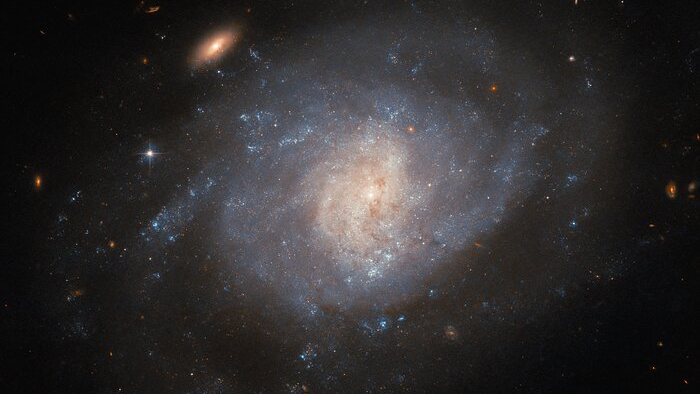
The Hubble Space Telescope snapped a new view of a hazy spiral galaxy that once hosted a supernova explosion.
The galaxy, formally known as NGC 941, lies about 55 million light-years from Earth. Its spiral arms are bright but not very well defined, swirling outward from a bright core into a faint halo of dimmer gas.
Hubble’s Advanced Camera for Surveys (ACS) observed the remnants of a stellar explosion within the galaxy. When some stars reach the end of their lives, they explode in a brilliant burst called a supernova, which can briefly outshine the entire galaxy in which it sits. This particular supernova, known as SN 2005ad, has since faded, leaving behind seeds for future star formation.
Related: The best Hubble Space Telescope images of all time!
Hubble's view captures the galaxy face-on, showcasing the realm's spiral structure and hazy surroundings. Using the Hubble data, SN 2005ad was also studied as part of a larger initiative to understand the environments in which hydrogen-rich supernovae, known as Type II, occur following the rapid collapse of a massive star, according to a statement from the European Space Agency (ESA).
However, the initial discovery of supernova SN 2005ad was made by an amateur astronomer named Kōichi Itagaki, who has discovered over 170 supernovae, according to the statement.
"This might raise the question of how an amateur astronomer could spot something like a supernova event before professional astronomers — who have access to telescopes such as Hubble," ESA officials said in the statement. "The answer is in part that the detection of supernovae is a mixture of skill, facilities and luck."
Supernovas can be detected by looking for brightness variations in the sky. These stellar explosions happen relatively fast, appearing very suddenly and then brightening and dimming over a period of days or weeks.
The amount of data Hubble collects in only a few hours of observations might take weeks, months, or even years, to process and analyze, which is why amateur astronomers play a key role in helping comb through the space telescope’s images. Amateur astronomers are also able to spend much more time actually observing the skies than professional astronomers who are assigned to specific tasks.
Many amateur astronomers have their own system of telescopes, computers and software that allow them to monitor the skies and detect astronomical events that may otherwise be missed — such as a supernova explosion. An online system, called the Transient Name Server, was established for reporting such discoveries.
"This is a big help to professional astronomers, because with supernova events time is truly of the essence," ESA officials said.
After Itagaki reported the discovery of SN 2005ab, professional astronomers were able to follow up with spectroscopic studies and confirm it as a type II supernova. Then, Hubble was aimed in the direction of NGC 941 to get a better view of the supernova and its surrounding environment, which astronomers might not have otherwise included in their study.
"Such a study wouldn’t be possible without a rich library of previous supernovae, built with the keen eyes of amateur astronomers," ESA officials said.
ESA released the new Hubble photo of NGC 941 online on Monday (Nov. 6).







